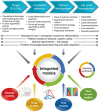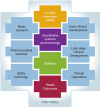Implementation of quantitative and systems pharmacology in large pharma
- PMID: 25338195
- PMCID: PMC4474169
- DOI: 10.1038/psp.2014.40
Implementation of quantitative and systems pharmacology in large pharma
Abstract
Quantitative and systems pharmacology concepts and tools are the foundation of the model-informed drug development paradigm at Merck for integrating knowledge, enabling decisions, and enhancing submissions. Rigorous prioritization of modeling and simulation activities has enabled key drug development decisions and led to a high return on investment through significant cost avoidance. Critical factors for the successful implementation, examples on impact on decision making with associated return of investment, and drivers for continued success are discussed.
Figures






References
-
- Krishna R., Schaefer H.G., Bjerrum O.J. Effective integration of systems biology, biomarkers, biosimulation, and modeling in streamlining drug development. J. Clin. Pharmacol. 2007;47:738–743. - PubMed
-
- Lalonde R.L., et al. Model-based drug development. Clin. Pharmacol. Ther. 2007;82:21–32. - PubMed
-
- Allerheiligen S.R. Next-generation model-based drug discovery and development: quantitative and systems pharmacology. Clin. Pharmacol. Ther. 2010;88:135–137. - PubMed
-
- Morgan P., et al. Can the flow of medicines be improved? Fundamental pharmacokinetic and pharmacological principles toward improving Phase II survival. Drug Discov. Today. 2012;17:419–424. - PubMed
-
- Milligan P.A., et al. Model-based drug development: a rational approach to efficiently accelerate drug development. Clin. Pharmacol. Ther. 2013;93:502–514. - PubMed
Publication types
LinkOut - more resources
Full Text Sources
Other Literature Sources

